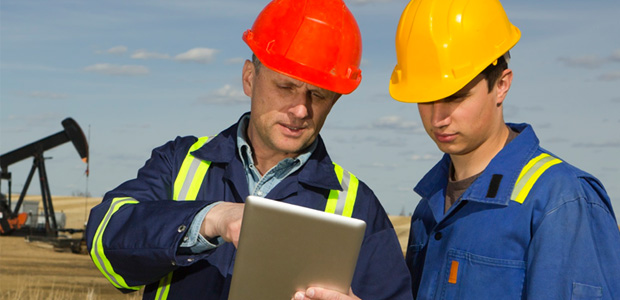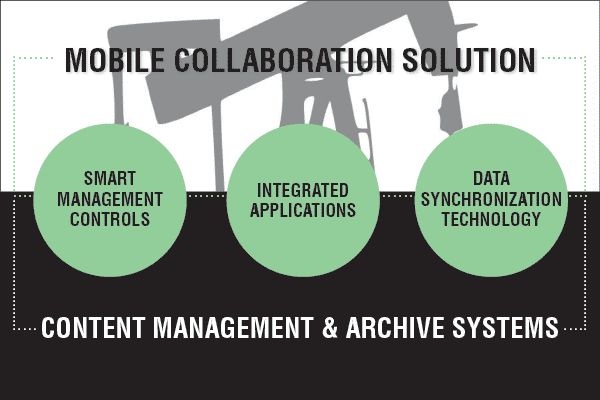
Mobile Collaboration
Mobile Collaboration Software Provides Access to Critical Data
By Barry Jinks
VANCOUVER, BRITISH COLUMBIA–Today’s drilling engineer is responsible for overseeing drilling operations from initial well design to testing, completion and abandonment. He is responsible for monitoring drilling progress and maintaining worker safety while ensuring compliance with dynamic operating, environmental and regulatory requirements.
He also needs to juggle on-site engineering analysis with performance reporting, cost control and contract administration while staying connected with contractors, suppliers and a multidisciplinary team of professionals.
Now consider what it’s like to effectively manage these tasks while on a remote land site, mobile unit or offshore drilling rig with limited access to the amenities many in the office take for granted, such as wireless Internet and instant access to critical enterprise information.
Drilling engineers require access to the most current versions of engineering data, safety standards and operating procedures. Because of an aging oil and gas workforce, this is especially relevant for mitigating the safety and liability risks that have arisen with the arrival of less experienced workers. In addition, drilling engineers need to upload site photos and revised project schedules, and to report operating results from the field.
How can this critical information be updated securely and accessed while in the field? How can relevant project information be shared collaboratively with other field workers, project team members and management? Further, how can this be accomplished when there is no (or inconsistent) connectivity because of the remote location of the drilling rig or challenging terrain?
Mobile Collaboration
The evolution of technology referred to as mobile collaboration software has made great strides toward credibly addressing the challenges of remote information access, sharing, and document management for the oil and gas industry. Put simply, this is software designed to ensure that enterprise information is made accessible to mobile workers, while maintaining corporate security and governance controls.
Mobile collaboration software is designed to extend the capabilities of trusted enterprise content management systems such as Microsoft SharePoint. When connected, the solution provides synchronized access to the corporate SharePoint information repository across all desktop and mobile devices such as smart phones, iPads, tablets and laptops.
However, for remote workers, mobile access to enterprise information also must be responsive to user requirements. To ensure engagement and adoption (and since not all workers are tech-savvy), mobile access should be simple, intuitive and easy to use. The application experience is truly a key differentiator for providing a simple and intuitive interface with corporate resources.
The mobile solution also should provide fast response times and efficient document search and retrieval capabilities. Further, remote workers should be able to quickly find and access the information they need–regardless of connectivity.
By having the most current version of key files delivered automatically and/or cached on their devices by smart synchronization technology, workers are much less likely to resort to “nonsanctioned” file transfers and storage options such as flash drives.
To summarize, from the user perspective, an effective mobile solution makes enterprise information easy to find, use and manage. The objective is to access critical enterprise information from any device, anytime, anywhere, including when offline.
From the organizational perspective, an effective mobile solution provides secure access to the enterprise information system (i.e., SharePoint repository) so that remote workers can access the critical information they need to work safely, productively and efficiently.
Industry Application
Enterprises that already have invested in robust content management infrastructure should not be required to re-engineer their business systems to embrace a more collaborative, mobile-enabled way of working.
Accordingly, an enterprise platform for mobile collaboration and information management should leverage the capability of existing systems. This ensures that a mobile solution can be deployed effectively not only for field-based applications, but also to support the unique information and collaboration requirements of large, complex projects with dispersed teams.
For example, maintaining an accurate and accessible record of project documentation is standard operating practice. Commercial, technical, legal, environmental, regulatory and consultation information specific to each project should be uploaded, tagged and archived securely in the enterprise system.
A mobile collaboration solution overlay ensures that project team members in both the field and office–including workers and consultants who are dispersed regionally and/or globally–can access and interact with this information from any device.
Further, this solution provides for exceptional IT visibility and control. That is, the organization can know precisely where critical information is and who has accessed and/or modified it. This approach helps safeguard valuable intellectual property and commercially sensitive information that is “touched” by multiple parties.
SharePoint typically serves as the foundational “content management and archive system” for enterprise and project information. The collaborative software solution extends the capabilities of the SharePoint system to mobile users through smart management controls, integrated applications, and data synchronization technology.
Smart Management
A control center or management console provides the intelligence to configure content access and manage data flow. Powerful analytical tools can be incorporated into the console to provide feedback to IT administrators on user activity.
Typically, the console will be built on a cloud-based server such as Microsoft Azure. The cloud service is used to run the software applications and provide for centralized configuration and deployment. To maintain security, no enterprise information is stored on the cloud. Core benefits of this approach are to:
- Streamline information access;
- Ensure all files remain securely on the protected company system; and
- Provide visibility to IT and business process owners for measuring users’ adoption and engagement of the mobile service.
Information is accessed and exchanged using a family of applications on the mobile devices of registered users. The apps are built around common tools such as Outlook, Windows Explorer and Mac Finder. This enables easy integration among the different operating systems and multitude of mobile devices used by project team members. Data they need access to are integrated into workflows they are used to accessing, both within Outlook and on their phones. It is reality that people prefer to interact with the systems and devices they know best and can access frequently.
Data synchronization technology provides the user with real-time access to enterprise content when he is connected to the wireless corporate network. This creates a collaborative workplace where mobile and dispersed workers have access to the same content and capabilities as their counterparts in the office.
Data synchronization technology can be configured (through the console) to automatically deliver critical information to the devices of mobile users, and can be cached for offline use. This is especially relevant when connectivity is an issue.
Likewise, the technology can identify and store content modifications made from each device, and can synchronize these changes back to the SharePoint repository with smart conflict resolution (such as for controlling file version).
The technology also can execute corporate governance and security requirements that are configured through the console. For example, sensitive files and data can be identified, encrypted and locked, and can be removed on demand from all devices. This ensures sensitive information is protected.
Digital Workplace Trends
We know that the oil and gas industry’s use of technology continues to grow rapidly. Organizations are increasingly using data collection and management tools to optimize the performance of field, pipeline and refinery assets. Upstream companies, for instance, use very sophisticated combinations of hardware, software and analytics to gather and process data from digital sensors in their oil and gas fields.
As the volume of data grows, and our reliance on data increases, effectively integrating data into corporate operational and information technology systems becomes even more important. Recall the drilling engineer example: This information “feedback loop” from the corporate IT system can be critical for effective decision making and optimizing field assets.
More generally, we also know that the industry trend toward digitizing data is not restricted to the upstream producing and operating environment. It is occurring rapidly across all segments of the industry, assisted in part by the resource transition from an older to a younger workforce.
With mobile devices in hand, the “new guard” of oil and gas workers is demanding instant access to enterprise information and systems, from both inside and outside the walls of the enterprise, so that they can be more productive, competitive and efficient.
At the same time, anecdotal evidence suggests some workers already are “drowning” in information, even as the volume, variety and velocity are set to increase further. Folks are being overwhelmed by a veritable tidal wave of information. It’s like drinking from a fire hose.
With these emerging demands, a key implementation challenge for IT departments is to enable solutions that do more than just provide mobility and connectivity. Robust business solutions also should be sufficiently intelligent to help employees “cut through the clutter” so they can easily find, share and manage relevant information. This helps to keep workers focused, engaged and productive.
Furthermore, mobile collaboration software can simplify many operational tasks and, when integrated with intuitive apps, improve business workflows. For example, a majority of field engineering work historically has been recorded with pen, paper, and a camera. Today, however, virtually every mobile device is equipped with GPS, high-quality photo/video capability, and wireless connectivity.
Accordingly, routine field work can be performed more effectively and efficiently (often from a single device). Basic incident reporting and service requests can be executed also to streamline workflows and compliance. The business outcome is to make organizations more efficient and agile.
Strategic Assessment
The clear industry trend is moving toward mobile solutions that provide access to enterprise information anytime, anywhere, from any device. More workers are getting connected–even some of the old guard who traditionally have resisted technology change. This is an important shift, especially since many of these senior employees are the keepers of critical technical and institutional know-how.
Accordingly, effective use of collaboration technology should endeavor to leverage not only better access to information, but also the unique knowledge and skill sets of employees who interact with it. Done well, this can help empower teams to collaborate more effectively and streamline the transfer of intellectual capital.
Despite these competitive advantages, however, there is still reluctance in the boardroom to make an enterprisewide commitment to mobile collaboration technology. The principal issue is risk. There are three key factors to consider:
Much higher volumes of enterprise data must be captured, analyzed, managed and stored. This makes for a very large and complex enterprise information repository.
There are increased needs and wants for full mobile information access and collaboration capabilities by the general workforce (i.e., not only remote workers and dispersed project team members).
There remains a clear need for an organization to protect sensitive information, and to meet strict regulatory and compliance obligations.
Put simply, at the same time more information (and more sensitive information) is being created, there are more people requesting unfettered access. The perception is that this creates an increased risk for information security.
This “access versus risk” dichotomy is a recognized dilemma for chief information officers, chief digital and security officers, and their IT departments. So, what to do?
Recommendations
In our view, oil and gas corporations and related service providers must learn to adapt and improvise. They must become more agile to stay competitive.
In part, this means embracing changes in the type, quantity and characteristics of the information being requested by the mobile workforce and dispersed project teams. As Charles Darwin stated, “In the long history of humankind . . . those who learned to collaborate and improvise most effectively have prevailed.”
However, corporations also must continue to protect critical information using more traditional methods. Safeguards are required to control access and prevent the loss of valuable data. Indeed, protecting energy extraction, production and distribution knowledge and systems is paramount, especially given the heightened threat to energy security from cyber and terrorist attacks.
Accordingly, corporate policies should balance the evolving need to provide for an agile and independent workforce with the traditional need for security and control. Both are important and there is no “one size fits all” approach.
Aligned with this transformation of the IT function is the potential for true thought leadership, whereby collaborative IT systems can serve a more advanced strategic function as critical information processer, curator, distributor and manager. With advanced analytics, companies are not only able to push out content, but also to configure, analyze, monitor and manage it.
In conclusion, the overarching purpose of an effective mobile collaboration solution for the oil and gas industry is to streamline information access/management between desktop and mobile devices for remote and globally dispersed workers and contractors.
The primary goals of mobile collaboration are to:
- Get the right content to the right people at the right time;
- Enhance decision-making capability;
- Reduce project cost;
- Mitigate scope and schedule issues; and
- Minimize legal, regulatory and environmental risk.
Industry leaders must adapt their strategic IT functions to become more agile and innovative in support of the ever-increasing information demands of a mobile workforce. At the same time, security and protection of critical data and systems must be strengthened to protect intellectual capital, maintain competitive advantage, and preserve energy security.

Barry Jinks is the founder and chief executive officer of Colligo Networks. He has been a technology innovator and entrepreneur for more than 25 years, and holds degrees in science and electrical engineering. Jinks is a recognized expert on SharePoint client technology and manages Colligo’s popular SharePoint blog. In addition, he is a frequent speaker at SharePoint and enterprise content management conferences worldwide. He was named Ernst and Young’s 1997 Pacific Region Entrepreneur of the Year for technology.
For other great articles about exploration, drilling, completions and production, subscribe to The American Oil & Gas Reporter and bookmark www.aogr.com.







